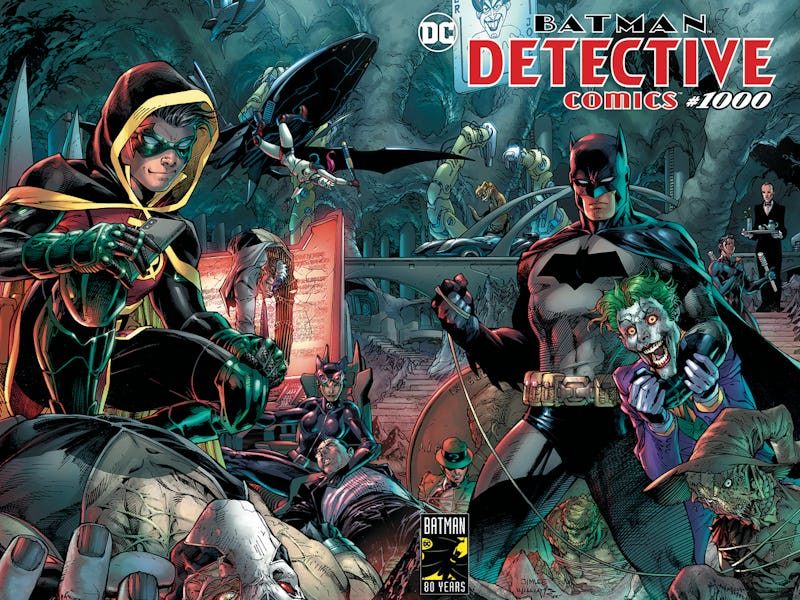In 'Detective Comics' #1000, Batman Reclaims the Gun That Killed His Family
Kevin Smith's story in the Batman anthology emphasizes his strongest storytelling theme.

For being 80 years old, Batman has never looked better. In Detective Comics #1000 — the landmark issue of DC’s namesake comic book series from 1939, out today —a murderer’s row of writers and artists spin their own takes on Batman in an anthology collection of new stories.
But in one story, written by Kevin Smith and illustrated by Jim Lee, the Dark Knight reclaims a relic that changed his life forever: The gun Joe Chill used to kill his parents.
In a collection with talents like Warren Ellis, Becky Cloonan, Christopher Priest, Scott Snyder, Paul Dini, and Geoff Johns, Smith’s story stands out as a personal tale packed with eight decades worth of emotion and sentimentality.
In “Manufacture For Use,” written by Smith, drawn by Lee, and inks, colors, and letters by Scott Williams, Alex Sinclair, and Todd Klein, Batman dons a disguise to visit an illegal pawn shop that sells wares left over from Batman’s battles with Gotham City’s villains. “If it featured in a Gotham crime, and it’s not in the GSPD evidence room,” brags the shopkeeper, “You’ll find it here.”
This guy has it all: “Goofy masks, giant hammers, elaborate death traps,” and it’s all yours if you can pay for it. “I got the goods that the bad guys left behind… after they got busted by the bat!”
When Bruce, in his disguise as Matches Malone (a concept introduced in Dennis O’Neil’s Batman #242) says he’s “not into this cosplay crap,” the shop owner reveals a collection of “the most famous guns in the history of Gotham City crime.” Bruce/Malone inquires about one in particular, a semi-automatic Glock handgun with a bandage wrapped on the handle.
Replies the salesman, “You remember the Wayne murders?”
Yes, indeed: Batman is out looking to buy the same gun that petty criminal Joe Chill used to murder Thomas and Martha Wayne in Crime Alley.
Preview of Smith and Lee's story in 'Detective Comics' #1000.
You know the origin story. Told in Detective Comics #33, Bruce Wayne’s parents are killed in front of him, which leads to a lifelong vow to fight Gotham City’s cowardly lot of criminals as Batman. And while Batman’s relationship with guns is sort of complicated (he used them plenty in his earliest stories), it’s largely accepted that Batman dislikes guns because of the trauma a gun inflicted upon him as a child. (He seems to have no problem with gatling turrets firing rubber bullets atop the Batmobile, though.)
But as Smith’s new story reveals, Batman isn’t looking for Joe Chill’s gun to add as a morbid piece in his Batcave. As his trusty butler Alfred protests, “Where’s the justice in letting this hunk of metal back into your life?”
Bruce tells him, it’s not going into the collection next to his life-sized t-rex and the Giant Penny (World’s Finest #30). “It’s never going to hurt anyone again,” he says. The comic shows Bruce smelting the gun and forging it into a chest shield embedded inside his bat-suit. “So the metal that broke my heart as a child? That same metal will protect my heart as a man. And that is justice.”
It may seem alien, perhaps inhuman, for Bruce to seek the weapon that killed his parents. In fact, in an alternate timeline (seen in the DC series Flashpoint), the explicitly emotionless Thomas Wayne — who became Batman after Bruce was the one to die in Crime Alley — kept Joe Chill’s gun on display in the Batcave. So, too, does Ben Affleck’s darker, grittier Batman in the DCEU (an unmarked gun in a locked box appears in Justice League).
The rest of 'Detective Comics' #1000 is also more than worth a pick-up this week. In Warren Ellis and Becky Cloonan's story, "The Batman's Design," the Dark Knight investigates and takes down a mercenary cult.
But sentimentality has always been one of Bruce Wayne’s defining characteristics, if also his greatest flaw. The Batcave is littered with mementos, both positive and negative, that Bruce keeps to remind himself of his biggest mistakes. From Jason Todd’s Robin costume to a letter written by his father, Batman is secretly one of the biggest hoarders in the DCU.
Smith, the director behind slacker ‘90s comedies like Clerks, Mallrats, Chasing Amy, and Dogma, is also a storyteller whose signature theme is sentimentality. Growing up as a comic book collector in lower working class New Jersey, Smith’s movies are packed with characters who achieve fulfillment in obtaining, or doing something, that means the world to them.
In Clerks, it was Dante (Brian O’Halloran) realizing how much he loves Veronica. In the sequel Clerks II, Dante and lifelong friend Randall (Jeff Anderson) buy and own the Quick Stop they once considered their own circle of hell. And Chasing Amy, arguably Smith’s most personal film to date, ends with protagonist Holden (Ben Affleck), an unfulfilled comic book creator, finally having “something to say” after his breakup with Alyssa (Joey Lauren Adams).
Whether it’s baseball cards (Cop Out), smut films (Zack and Miri Make a Porno), or wanting to get pregnant (Dogma), Smith’s storytelling is rooted in what tangible thing characters want the most. For Batman in “Manufacture For Use,” it’s Batman looking for his very reason for being and using it to save his life.
Detective Comics #1000 is available now.